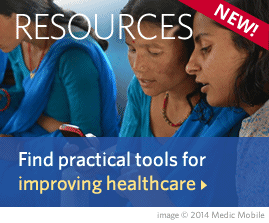To strengthen midwives’ abilities to overcome health system challenges and deliver improved services, the USAID-funded Leadership, Management & Governance project developed the LMG for Midwifery Managers certificate course. This course consists of a five-day offsite workshop focused on six areas prioritized by a skills gap assessment: assertive communication, advocacy, mentoring, data use for decision-making, change management, and strategic problem solving.
Read More...Showing results for: Strategic Planning
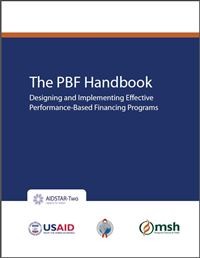
Performance-based Financing (PBF) is a powerful means of increasing the quality and quantity of health services by providing incentives to suppliers to improve performance and achieve results. PBF can increase the use and quality of health services, stabilize or decrease the costs of these services, help use limited resources effectively, and improve staff motivation and morale, a proven incentive for staff retention.
This PBF handbook has been designed for use by both program design officers at US Government (USG) agencies at the central and country levels as well as for PBF implementers at national and local levels. It is our hope that presenting this comprehensive overview of PBF from both the funders’ and the implementers’ perspectives will help to facilitate the design, implementation, and evaluation of PBF programs that enhance service delivery and create positive health outcomes.
Read More...
This issue of The Manager provides a comprehensive framework for addressing human capacity development. It presents steps for developing a strategy that will help managers sustain a supply of adequately trained health staff. It examines four components of planning and managing the workforce: polocy and financial requirements, human resource management, partnerships, and leadership. The issue also suggests actions managers and policymakers can take to address issues in these areas so that appropriately trained staff are available in the right place at the right time.
Read More...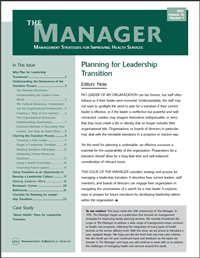
This issue of The Manager considers strategy and process for managing a leadership transition. It describes how current leaders, staff members, and boards of directors can engage their organization in navigating the uncertainties of a search for a new leader. It explores ways to prepare for future transitions by developing leadership talents within the organization.
Read More...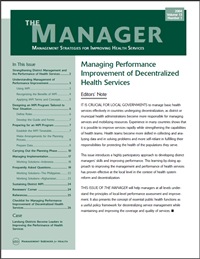
This issue of The Manager will help managers at all levels understand the principles of the local-level performance assessment and improvement. It also presents the concept of essential public health functions as a useful policy framework for decentralizing service management, while maintaining and improving the coverage and quality of services.
Read More...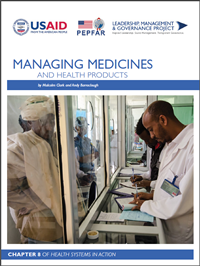
The publication outlines the essential elements of managing supplies at the district and subdistrict levels and in nongovernmental organizations (NGOs), provides practical guidance in assessing and improving the supply system at that level, and offers a range of other technical and managerial resources and references that will enable you to improve your management skills and study the areas that interest you further. Each section also provides overviews, guidelines, and checklists that will help you and your team identify and resolve major problems. (This publication is Chapter 8 of Health Systems in Action: An eHandbook for Leaders and Managers.)
Read More...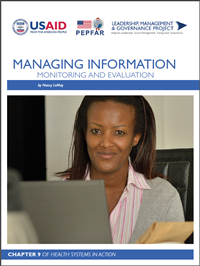
This publication is a practical guide that you, the manager of a health program or of health services, can use to understand and organize essential practices that will improve the monitoring and evaluation (M&E) of health services. It explains the role and function of an effective health information system (HIS). It describes monitoring and evaluation as key program management functions, explains the difference between the two, and offers considerations for making each function more useful to you for learning and action. It also shows how good leadership and management practices are relevant to M&E. (This publication is Chapter 9 of Health Systems in Action: An eHandbook for Leaders and Managers.)
Read More...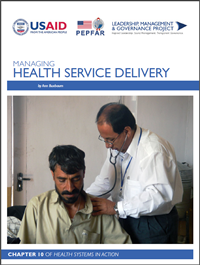
This publication explores the ways in which the health service delivery system interfaces with and builds on the management systems discussed in the earlier chapters of this handbook. You will see how improving the management and leadership of the health service delivery system improves access to and quality of services. You will observe the importance of strong systems in fostering a positive relationship between clients and providers at service delivery sites— “points of care”—at all levels of the health system, leading to desired health outcomes.
Read More...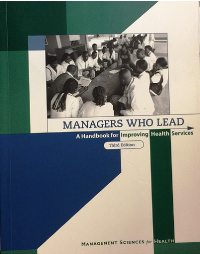
Managers Who Lead empowers health managers at all levels of an organization to lead teams to face challenges and achieve results. It answers questions such…
Read More...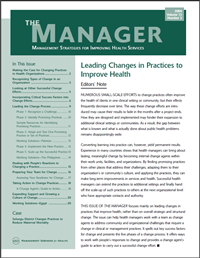
This issue of The Manager focuses mainly on leading change in practices that improve health, rather than on overall strategic and structual change. The issue can help health managers work with a team as change agents to address community and organizational challenges that require a change in clinical or management practices. It spells out key success factors for change and presents the five phases of a change process. It offers ways to work with people’s responses to change and provides a change agent’s guide to action to carry out a successful change effort.
Read More...



